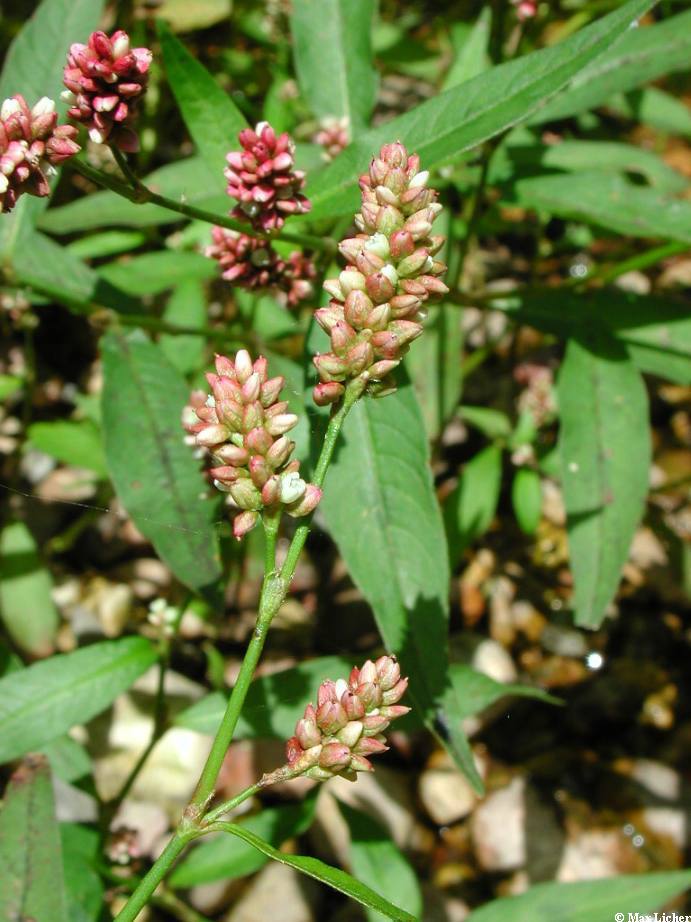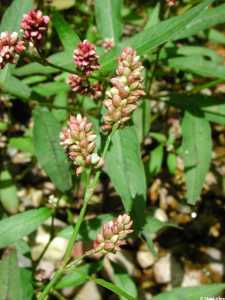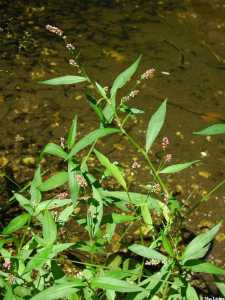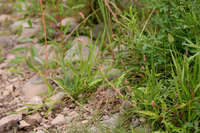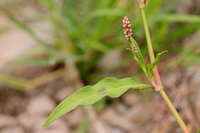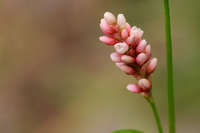Plants annual, (0.5-)1-7(-13) dm; roots also often arising from proximal nodes; rhizomes and stolons absent. Stems procumbent, decumbent, ascending, or erect, simple or branched, without obvious ribs, glabrous or appressed-pubescent. Leaves: ocrea light brown, cylindric, 4-10(-15) mm, chartaceous, base inflated, margins truncate, ciliate with hairs 1-3.5(-5) mm, surface glabrous or strigose, rarely with spreading hairs, not glandular-punctate; petiole 0.1-0.8 cm, glabrous or strigose, leaves sometimes sessile; blade often with dark triangular or lunate blotch adaxially, lanceolate to narrowly ovate, (1-)5-10(-18) × (0.2-)1-2.5(-4) cm, base tapered or cuneate, margins antrorsely strigose, apex acute to acuminate, faces glabrous or strigose, especially along midveins, sometimes glandular-punctate abaxially. Inflorescences terminal and axillary, erect, usually uninterrupted, 10-45(-60) × 7-12 mm; peduncle 10-50 mm, glabrous or, rarely, pubescent; ocreolae overlapping or sometimes interrupted proximally, margins ciliate with bristles 0.2-1.3(-2) mm. Pedicels ascending, 1-2.5 mm. Flowers 4-14 per ocreate fascicle, homostylous; perianth greenish white proximally and roseate distally or entirely roseate, not glandular-punctate, scarcely accrescent; tepals 4-5, connate ca. 1/ 3 their length, obovate, 2-3.5 mm, veins prominent, not anchor-shaped, margins entire, apex obtuse to rounded; stamens 4-8, included; anthers yellow or pink, ovate; styles 2-3, connate proximally. Achenes included or apex exserted, brownish black to black, discoid or biconvex to 3-gonous, (1.9-)2-2.7 × (1.5-) 1.8-2.2 mm, shiny, smooth. 2n = 44.
Flowering Mar-Nov. Weedy, moist semiwaste to cultivated areas; 0-2500 m; introduced; Greenland; St. Pierre and Miquelon; Alta., B.C., Man., N.B., Nfld. and Labr., N.S., Ont., P.E.I., Que., Sask., Yukon; Ala., Alaska, Ariz., Ark., Calif., Colo., Conn., Del., D.C., Fla., Ga., Idaho, Ill., Ind., Iowa, Kans., Ky., La., Maine, Md., Mass., Mich., Minn., Miss., Mo., Mont., Nebr., Nev., N.H., N.J., N.Mex., N.Y., N.C., N.Dak., Ohio, Okla., Oreg., Pa., R.I., S.C., S.Dak., Tenn., Tex., Utah, Vt., Va., Wash., W.Va., Wis., Wyo.; Eurasia; Africa; Pacific Islands (New Zealand).
An allozyme study by L. L. Consaul et al. (1991) provided evidence of the allotetraploid origin of Persicaria maculosa, with P. lapathifolium as one of the parents. Plants with stems spreading-hairy and peduncles stipitate-glandular have been named P. maculosa subsp. hirsuticaulis (Danser) S. Ekman & Knutsson. Material referable to this subspecies has not been seen among North American specimens. Hybrids between P. maculosa and P. minor have been documented in Europe (R. H. Roberts 1977).
The Cherokee, Chippewa, and Iroquois prepared simple or compound decoctions of Persicaria maculosa, which they used as dermatological, urinary, gastrointestinal, and veterinary aids, for heart medicine, and as an analgesic (D. E. Moerman 1998).
Frequent throughout the state in wet ground along roadsides and streams and in woodland and fallow fields. This species begins to flower much earlier than P. hydropiperoides. It and others of the genus are the source of smartweed honey.
Duration: Annual
Nativity: Non-Native
Lifeform: Forb/Herb
General: Annual with erect to ascending or decumbent stems, usually branched from base, 20-80 cm or more long, glabrous or purberulent.
Leaves: Alternate, linear-lanceolate to lanceolate, 2-18 cm long, nearly sessile, cuneate at base, acuminate at the apex, punctate, marked by a purplish spot near the middle of the blade, ciliate ocrea.
Flowers: Spikelike racemes, ascending to erect, sepals pink to purple, rarely white, 2-4 mm long, usually 6 stamens.
Fruits: Achenes 3-angled or lenticular, 2-3 mm long, lustrous black, smooth.
Ecology: Found in wet soil and marshy ground along streams from 4,500-8,000 ft (1372-2438 m); flowers July-September.
Notes: Distinguished clearly by the purplish spot in the middle of the leaf blade. Nomenclatural problems rear their ugly heads: this species is identified by FNA as being Persicaria maculosa but USDA Plants DB continues to refer to this as Polygonum persicaria. For consistency, the former is considered here to maintain its presence within the Persicaria complex.
Ethnobotany: Used as a poultice for pain, crushed leaves rubbed on poison ivy, taken for urinary problems, for stomach pain, feet and legs soaked in it for rheumatism, taken for heart troubles, and rubbed on horses to keep flies away.
Etymology: Polygonum is derived from Greek polys, many, and gonu, knee or joint, while persicaria is medieval name of knotweed, from Persica, or peach, an allusion to the leaf shape.
Synonyms: Polygonum persicaria, Persicaria persicaria, Persicaria ruderalis, Persicaria ruderalis var. vulgaris, Persicaria vulgaris, Polygonum dubium, Polygonum fudiforme, Polygonum minus, Polygonum minus var. subcontinuum, Polygonum persicaria var. angustifolium,
Editor: SBuckley, 2010
Erect or ascending annual to 8 dm, often much branched, glabrous or nearly so; lvs narrowly lanceolate, often with a dark blotch; ocreae membranous, strigillose, short-ciliate; spikes dense, straight, cylindric, 1-4 cm נ7-12 mm; ocreolae obliquely truncate, entire or with a few short cilia to 1 mm, pedicels mostly included; perianth pink or rose, 2-3.5 mm; achenes lenticular or occasionally trigonous, black, smooth and shining, broadly ovate, 1.8-3 mm, averaging four-fifths as wide; 2n=44. Native of Europe, now a common weed throughout our range, s. to Fla. and Tex., and w. to Alaska and Calif. (P. dubium; P. maculosum; P. puritanorum; Persicaria persicaria)
Gleason, Henry A. & Cronquist, Arthur J. 1991. Manual of vascular plants of northeastern United States and adjacent Canada. lxxv + 910 pp.
©The New York Botanical Garden. All rights reserved. Used by permission.


